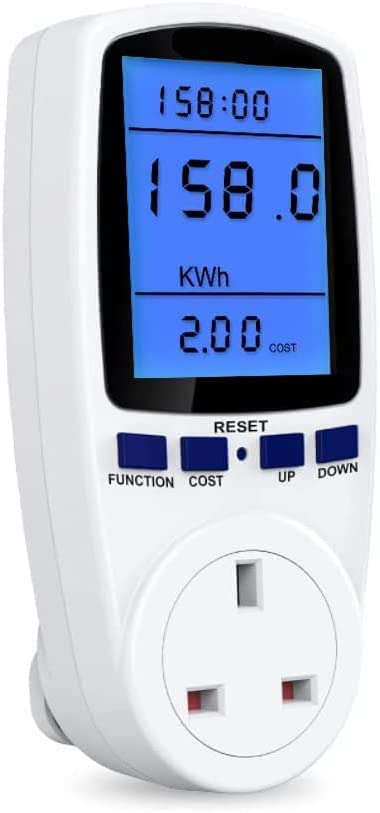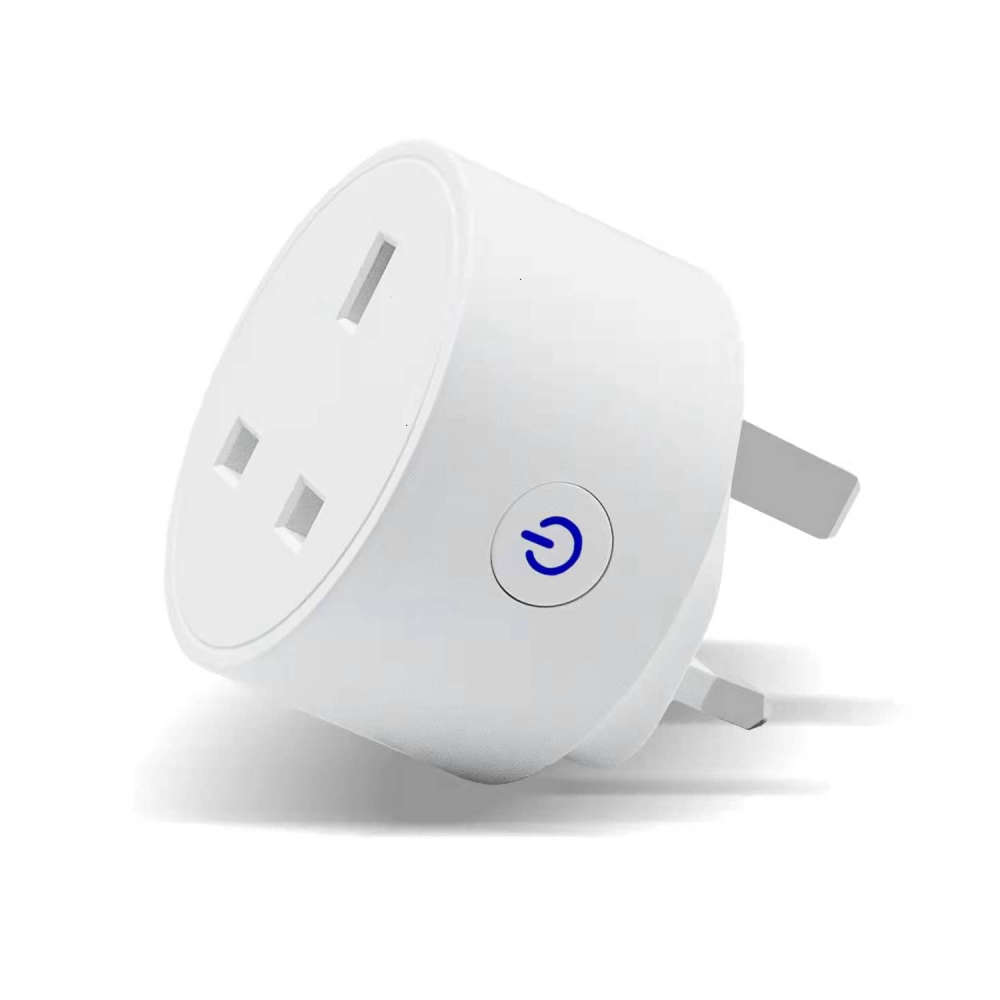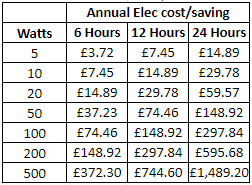How to Save Money on your Energy Bill
Why should I read this?
Hi, I'm Glyn - by day I present Saturday Breakfast on Thornbury Radio. The rest of the time I run the technical stuff at the station. I'd like to share the insights I have from being an Electrical Engineer, without making it all too technical! If you have any questions, observations or extra tips then email me at glyn@thornbury.radio.
Why read this? For the "Three P's"
-
- Pounds - To help save you £££ money
- Pollution - To help you reduce your carbon footprint and reduce your impact on climate change
- Putin - To help reduce reliance on Russian gas supplies and reduce the chances of power cuts this winter.
The Price Cap does NOT limit what you will pay!
 Please, please know that the Government’s price cap does NOT mean your energy bills will be capped at £2500! This is a really bad bit of public information communication from the Government
Please, please know that the Government’s price cap does NOT mean your energy bills will be capped at £2500! This is a really bad bit of public information communication from the Government
The £2500 cap figure comes from a fictional “average” household. In reality virtually no one lives in an “average household” most of us are above or below average.
Instead, it is the price of an energy unit (technically known as a kWh) that has been capped. A few years ago it was (uncapped) at around 15p a unit. In October 2022 it is (currently) capped at around 34p an unit, and Martin Lewis estimates it will increase to 58p a unit in April 2023. Think of units a bit like the price of a kg or lb of potatoes. ie: it’s equivalent to the price of spuds next year being nearly x4 what they were a few years ago – but worse news is that you probably buy a lot more energy units that you do spuds!
Important point - This means the more energy (spuds) you use, the more you will pay. The less you use, the less you will pay. The more prices go up, the bigger the impact of the advice in this article.
Understanding your electricity bill
Your electricity bill is calculated from a combination of a daily standing charge (a bit like “line rental”) plus a charge for how much electricity you use (ie: how many chips you eat if we continue the potato analogy!)
Thus (depending on your supplier and tariff) if you use 5000 units a year, on October 2022 prices, your annual *electricity* bill might be:
365 x 46.356p per day standing charge plus 5000 x 34.037p energy unit charge = £1871. Remember that’s electricity only, excluding gas.
If you are new to all of this, then let’s not go any deeper for now into units, kWh and kW for now, but there are some more details in the Appendix at the end - hopefully you will want to understand more after reading this, if not, then let’s skip to the interesting bit…..!
What can I do?
First we need to get you a bit energy-savvy. This is second-nature to Electrical Engineers like me, but is not so obvious for normal people! The aim is to try to identify things that unnecessarily are consuming energy and costing you money. So this is a balance of these factors:
- How useful/valuable is the energy consumption?
- How much power per hour is it using?
- How long is it on?
Take three contrasting examples:
-
- Electric radiator in chidren’s nursery. Medium power, switched on for long periods of the day, so expensive. But essential, so out of bounds for this project!
- Broadband WiFi router – pretty low power, but on 24x7x365. Provides a useful (essential?) function for most of the day, and there are technical reasons to perhaps not turn it off overnight. This is a possible, but not a definite target for this project.
- Audio visual system on standby. Low power consumption, so does not cost much per day, but 365 days a year it adds up. Standby consumption is not adding useful value, so a real no-brainer target for this project!
The above examples are just that to illustrate the point on the balance between useful function, power and time - they may not necessarily apply to your household!
Measuring power consumption
 I strongly recommend you purchase a plug-in power meter device. There are loads on Ebay and Amazon at £15 or less or around £18 at Screwfix. You plug these between your device and the plug socket. They tell you how much power that device is using. If you read the instructions you can also set them to measure how much energy (=power x time) that the device uses a over a day, week etc. (useful for things with variable power consumption like fridges, dishwashers etc).
I strongly recommend you purchase a plug-in power meter device. There are loads on Ebay and Amazon at £15 or less or around £18 at Screwfix. You plug these between your device and the plug socket. They tell you how much power that device is using. If you read the instructions you can also set them to measure how much energy (=power x time) that the device uses a over a day, week etc. (useful for things with variable power consumption like fridges, dishwashers etc).
Armed with this device, get measuring! My advice is to measure things that are permanently plugged in. Typically we want to find “vampire” devices that are costing you 24 x 7 x 365. As a rule of thumb, at Oct 2022 prices, the cost to you is £3 per watt per year for devices that are powered 24x7. So, for example a 20watt Broadband/WiFi router is costing £60 per year.
When you rampage around your house with your power meter you may, or may not, get results like this:
- Phone chargers – 0 watts when not charging a phone. Forget worrying about them unless they are warm, in which case you will definitely measure more than 0 watts and should consider buying a replacement charger!
- TV on standby – typically 0.5-1 watt. Not really worth worrying about
- Listening to radio on your TV - typically 200 watts and is on for long periods of the day. Buy a proper radio rather than wasting energy displaying a radio station logo!
- Cordless phone – say 3w per phone. Starting to think how often I need to use the fixed phone – so a possible target for unplugging.
- Dishwasher – surprisingly, ours uses 7w continuously on standby when not being used. That’s £21 a year for no useful purpose. We now turn it off until we want to use it!
- Satellite receiver and audio-visual systems. Sometimes these can be using 30-40watts on standby – that’s £90-120 per year at Oct 2022 prices – a definite target to switch off overnight!
- Lighting – you can’t easily measure these using this plug-in device, but check what sort of bulbs you are using. If it’s an old-fashioned filament bulb you should definitely consider replacing it, especially if it’s on for a long time like in the hall or landing. A single old-fashioned 100w light bulb could be replaced by a 10w LED bulb, saving you £270 a year if it were on 24x7 – so say £67 per year if on 6 hours a day. It would pay for itself in less than a month!
- Other lights to consider:
- Fluorescent strip lights use 70 watts or more (£210 per year 24x7).
- Outdoor 500w PIR security lights use 500w (£1489.20 per year if 24x7, but realistically still £60 a year if only on an hour per night)
- Extra fridge? Maybe you have a beer fridge in the garage or utility room. That’s probably costing £150 per year at Oct 2022 prices. Do you really need to keep it running during this period of high energy prices?
- Kettle – 3kW or 3000 watts. Really powerful, but hopefully not on for long. Make sure you only boil what you need, don’t fill it up unless you need it all!
- Dishwasher – typically 2.5kW or 2500watts, but not continuously. Take the time to use the power/energy meter to measure how much energy (kWh) it uses on the different programmes – you might be able to save ~£50 a year here by using a more economical program (we did, by swapping from "Eco" to standard 45 degree wash). Never run it when not full!
- Oven – Typically 2-3kw or 2000-3000 watts and on for long periods of time. Tons of energy, but it’s performing a useful function, so maybe don’t worry about it! If you are a small family consider a smaller oven or air-fryer that uses slightly less power but is smaller, so heats up quicker so uses a bit, but not a huge amount, less energy.
- Electrical underfloor heating – maybe 2-5kW or 2000-5000 watts and on for long periods of time. Really costly. Maybe consider not using it while electricity prices are so high, if possible?
Advice
- Warmth or heat is a big giveaway that lots of energy is being used. Target these devices (both the device itself and the plug in power adapter if applicable).

- Consider purchasing smart plugs to automatically turn things off when they are not needed. You “could” use normal mechanical timer plugs, but smart plugs are now similar price (4 for £25) and don’t time-drift. Also they can easily be checked and turned on/off remotely by smartphone app, or even by your voice, or automatically by external triggers such as email etc (for the geeks!)
- Broadband/WiFi router is a tempting one to turn off overnight, perhaps saving £20-30 a year. BUT the broadband service provider’s equipment might interpret it as an intermittent connection and ramp-down your broadband speed to try to improve reliability. If you try this measure, be aware of this, and if your speed decreases, perhaps stop turning it off! (It may take a week or more to gradually recover the speed)
Cooking Tips
Cooking is probably one of the biggest consumers of energy in any house. You can't avoid it, but you can maybe shave some costs away:
-
Boiling water - as with kettles try to minimise the amount of water you use to cook potatoes, pasta etc. Also cover the pan when boiling and turn the heat right down to what is just needed to keep it boiling. Consider investing in a silicone boil-over stopper cover - they are brilliant!
-
A tip from Jamie Oliver - if making mash, chop the potatoes smaller so they cook quicker. Say 1cm (half inch) lumps
-
Use a larger pan to boil things - means you can use less water to cover the potato/pasta, and there is more area to contact the heat source
-
Consider stacking pans or steamers - one heat source could cook multiple things.
-
Be aware that mains gas is about one third of the cost of electricity for heating. OK some of that energy may be wasted if the flames lick up the side of the pan. But overall it might be best to not pre-boil water in an electric kettle.
-
Slow cookers are cheap to run, but maybe not as cheap as people imagine. Typically they use about 150w, which means they use 1.2 kWh (units) of electricity over 8 hours. In contrast that is about the same amount of energy as a large oven on 180 degrees for 30 minutes, more or less.
Old Wives' Tales
All sorts of energy-saving rubbish is written in articles in tabloids and internet blogs. Here are a few common ones:
-
- “Wall warts” and phone chargers – despite what they say, I’ve never found a phone charger that consumes any energy whilst plugged in and not charging a phone. If it’s not warm, forget it! If it's warm, or worse hot, then throw it away and replace it.
- TV on standby. I’ve never found a TV that uses more than 1 watt on standby – that’s £3 a year at October 2022 prices. Not worth worrying about
- Turning off fridge overnight. NO! It will just warm up and have to work extra hard the next day to cool down again. If you really need to save on refrigeration costs consider increasing the temperature setting – say to -15degC for freezer and say 5degC for fridge (NB: at your own risk - this may not comply with food hygiene recommendations!)
- Hot water flask. Some people advocate filling a flask with boiling water in the morning to use throughout the day for making tea/coffee. Silly idea because a) It will not stay boiling and b) It will not use any less energy than boiling what you need each time. Plus, there is a big risk you will not use it all and so waste energy by tipping away warm water at the end of the day.
- Buying a more efficient kettle (the Boris Johnson suggestion). Any electrical heating element is effectively 100% efficient – if it works then you can’t get any electrical heater that’s more efficient. Don’t waste your money!
- Mains Gas is approx one third of the price per kWh of electricity. Thus, if you want heat, it might be cheaper to use mains gas for boiling water, heating rooms etc.
- Lights – as long as they are LED don’t worry too much about them, within reason. Concentrate on things that use more power. Better to leave lights on for a while than to trip over something in the dark! In hall/landing consider motion-activated bulbs available for £10 or less. But if you have old-fashioned filament (tungsten) bulbs, or worse, halogen bulbs, then seriously consider replacing them with LED bulbs using approx. 90% less energy.
Summary
I’ve recently completed this exercise around our house. I estimate we are now saving £300 to £400 per year, a 10-20% reduction in our bill. This results in a smaller carbon footprint and if repeated in every household could significantly reduce the chances of power cuts this winter.
The key thing is to target devices that are wasting energy 24 hours a day without providing a useful service. Investment in a plug-in power meter helps you find the worst offenders, and investment in some smart plugs let you automatically turn things off and on as many times a day as you want, and remotely via a smartphone app. Electricity is so expensive (and set to get even more expensive in January and then again in April 2023), these investments can pay back very quickly indeed.
Appendix - Understanding your electricity bill, Units, kWh and kW
Many/most people don’t understand this bit, but to control your costs it’s really important to understand how electricity is charged. It is charged in “Units”. These are also known as kWh which means kilo-Watt hours. That sounds a bit technical, but think of electricity like potatoes. Units (or kWh) are like the weight of potatoes in kg or lb. The more electricity (=potatoes) you use, the more you pay.
-
- Unless you are on a pre-payment meter, you probably pay by monthly direct debit. The amount you pay is a rather vague calculation based upon a secret calculation that your energy provider uses which is based upon your average annual consumption which they try to average to a fixed monthly charge to avoid seasonal fluctuations. I strongly suspect their calculation is designed to try to make you pay too much so that you invariably end up in credit – giving them free loans!
- I advise you take control of what you pay by understanding the calculation of what your bill “should” be. For starters, dig out a bill from as many years ago as you have. Using a bit of maths and a calculator or a spreadsheet you should be able to calculate how many Units (kWh) you have used between then and now. Subtract today’s meter reading from the old meter reading and divide by the time elapsed in years, months, weeks or days. In a normal house you’ll probably end up with a figure between say 3000 and 10000 units of electricity per year, depending on house size, family size etc.
- The next thing is to understand is the difference between kWh and kW.
- A reminder – kWh means Kilo-Watt-hour. This is a measure of energy (power x time) – which is how you are billed by your energy company
- In contrast, a kW is a kilo-Watt. This is a measure of power – which means the amount of energy per second, minute, hour (or whatever timescale you want) it consumes.
- Remember 1kw = 1000 w or 1000 watts
- Thus a device with a power of 1kW switched on for an hour continuously will use 1kWh (=1 unit) of electricity – roughly 34p at Oct 22 prices.
- Similarly a 3kW kettle boiling continuously for half an hour uses 3 x 0.5 = 1.5kWh (1.5 units) of electricity – roughly 50p at Oct 22 prices.
- An old fashioned 100w (=0.1kW) filament electric light bulb if left switched on uses 0.1 x 24 = 2.4kWh per day (approx £1 per day at Oct 2022 prices)
- TEST – Your 500w PIR security light has been stuck permanently on for the last couple of days. How much will it cost per year if you don’t sort it out?
- Answer = 0.5 x 24 x 365 x £0.34 = £1489.20
- Yikes!
Link to calculator tool
- Perhaps the above explanation is a bit too heavy for you?! If so, no worries - if you click on the link below it should open a simple spreadsheet with two tools. One tab lets you calculate how much a device will cost (or save) you per year, based upon your unit price, its power and hours per day that you enter in the yellow cells. The second tab gives the annual cost/savings for a range of device powers and hours per day. A couple of screen grabs below.
- Link to electricity cost calculator tool


Questions or observations? Email me at glyn*at*thornbury.radio




